It’s safe to say chatbots have truly taken over the world.
We know because we checked it.
Our study confirmed that almost 1.5 million people had at least one conversation with a chatbot within the past year.
But what does this mean for businesses? Especially those who haven’t yet adopted AI and chatbots into their customer service strategy?
It’s a perfect moment to have a pulse check and explore attitudes towards chatbots among companies and online shoppers. We surveyed 774 online business owners and 767 customers to find out what are the current chatbot statistics and trends.
Skyrocket your business with powerful AI chatbots
Let’s get right into the most exciting chatbots trends.
Key chatbot statistics
A clear trend for the second half of 2024 and 2025 is the ever-growing prevalence of chatbots, which are expected to become more and more advanced.
Gone are the days of complicated bots that required lots of coding, AI hallucinations, and unhelpful virtual assistants driving people mad. Intelligent, versatile, and easy-to-handle chatbots will further revolutionize customer service and expand into fields like marketing, human resources, and operations.

Our survey revealed that:
About 60% of business owners believe that AI chatbots can help to improve their customers’ experience
This is a major win for the AI industry. Trust in chatbots keeps growing each year, thanks to their ability to analyze large data sets, spot patterns, and offer real-time, personalized solutions. More and more companies are realizing why chatbots are important. By automating routine tasks and delivering tailored recommendations, chatbots enhance support, boost accuracy, and increase customer satisfaction.
Still, around 50% of people have concerns about using AI
The most frequently mentioned concerns include costs, the possibility of mistakes, lack of human qualities, and shortage of relevant skills or knowledge. This is understandable—the AI boom is a relatively new phenomenon, and adapting to it takes time. The good news is that technology is improving every single day, and creating safe, accessible AI is now a reality, not just a distant goal.
Read more: Check out how Lyro is revolutionizing customer service with intelligent AI customer support.
Almost 70% of businesses want to feed AI with internal knowledge and past support conversations
Feeding internal knowledge to AI for customer support is extremely useful— that’s how you can automate your FAQs and ensure that customers get up-to-date information. The most popular data storage platform among our respondents is Google Drive: about 60% of people want to feed AI with information stored exactly there. And about 17% of business owners update their internal knowledge at least once a day, and expect their AI customer service solution to keep up with it.
About 82% of respondents would talk to a chatbot if there was any waiting involved in talking to a human representative
53% of our respondents selected being put on hold or waiting for a reply as extremely frustrating. Only 18% of people are ready to wait 15 minutes to ask a support question to a live agent. So, as you can see, long waiting times can cost your business considerably in customer satisfaction and revenue loss.
A whopping 94% of people agree that chatbots will make traditional call centers obsolete
This was completely unimaginable not long ago. However, now people have experienced the benefits of AI in customer service, and they’re ready for a revolution. Chatbots have become so effective that they convinced everyone but 5% that they are going to rule the industry. For businesses that haven’t yet adopted AI customer support software, this number should be taken as a call to action.
More than 96% of respondents think that businesses that use chatbots take good care of their customers
This directly answers the question “Do customers like chatbots?” and addresses the common misconception that only lazy businesses rely on chatbots. In fact, AI chatbots can store incredible amounts of data, reply in seconds, and answer questions with precision and efficiency. Businesses know that and want the best for their customers, hence, adopt the most optimal tools for stellar customer service.
About 90% of customer queries are resolved in fewer than 11 messages
Most chatbot conversations are quick and direct, with an average of just 11 exchanges per thread. Nearly all issues are resolved in minutes. This gives chatbot designers control over the user experience, conversation flow, and how quickly responses are delivered.
By 2025, the number of businesses using AI chatbots is projected to increase by 34%
How many companies use chatbots? As of today, roughly 60% of B2B and 42% of B2C companies use chatbot software. With a 34% increase by 2025, it’s safe to say that we will live through the chatbot revolution. Given more tools, better functionalities, and increasing business value, AI bots have become a must.
Now, what about chatbot market size and its growth?
Chatbot market size and adoption rate
By 2028, the chatbot market is expected to reach $15.5 billion, up from $4.7 billion in 2020. With a steady annual growth rate of about 23%, this surge reflects the rising demand for efficient and cost-effective AI solutions.
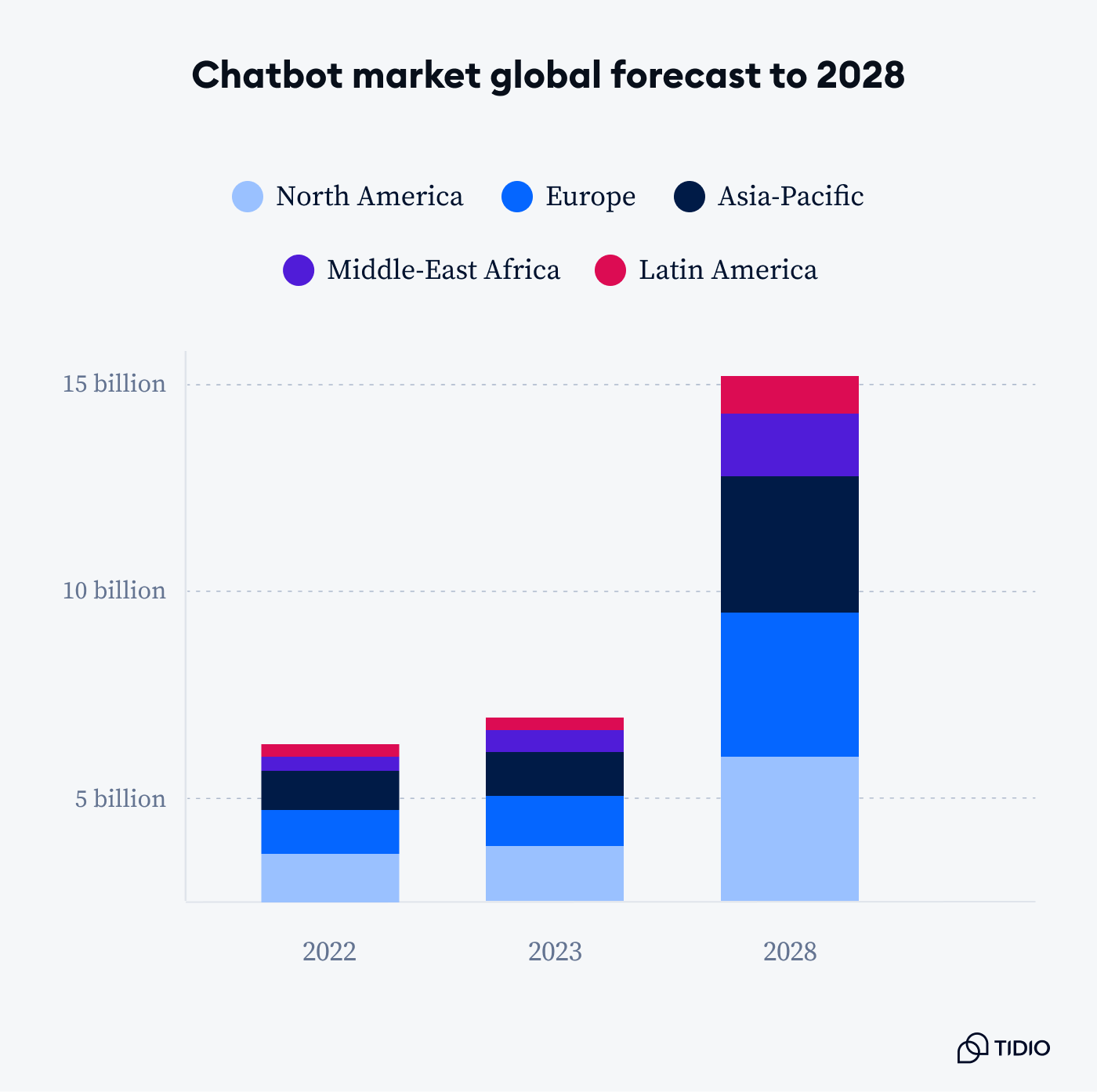
Smaller businesses are quickly adopting chatbots because it’s easy to integrate a third-party chatbot builder. On the other hand, larger businesses tend to take a different approach and tailor their in-house solution, which makes the development process much longer.
Voice assistants, alongside text-based bots, are becoming more popular. In 2024, over 8.4 million businesses are using voice assistance, with a modest growth rate of 2.9% year-over-year. However, as the technology improves, steady growth is expected.
A key trend for 2024 and beyond is the rise of AI-powered chatbots, led by models like GPT-4 and other large language models (LLMs). GPT-4, developed by OpenAI, marks a big leap from GPT-3, offering more accurate and human-like language processing.
Other advanced LLMs, like Google’s PaLM 2, Anthropic’s Claude 2, and Meta’s LLaMA, are also gaining ground. These models are being integrated into sectors such as ecommerce, healthcare, and education, allowing businesses to offer more personalized and efficient services.
Looking ahead to 2025, simple rule-based chatbots will no longer be enough. To stay competitive, companies must adopt LLM-powered bots to provide real-time, context-aware support and automate complex tasks, improving customer experiences.
With the growing market demand, let’s explore how many businesses use AI bots in their daily operations.
What percentage of businesses use chatbots?
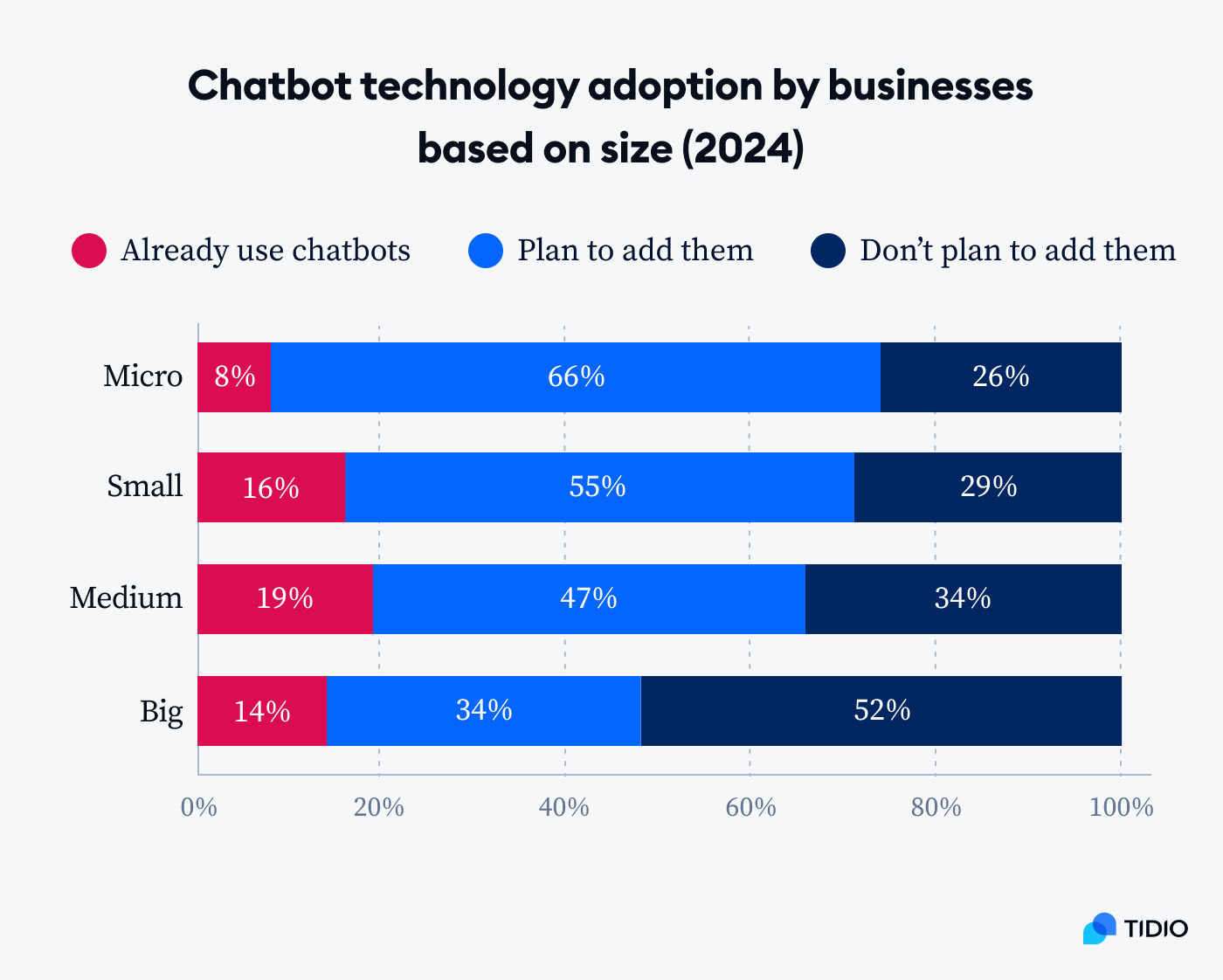
Businesses of all sizes can benefit from chatbot technology. But we found that small businesses are willing to embrace the technology at a faster rate than larger businesses. The reason for this could be that they often have fewer resources and need to find the most efficient ways to connect with their customers.
But do AI chatbots help businesses achieve their goals?
Are chatbots effective?
Chatbots are regularly used by millions of people. In fact, our study found that almost 27% of shoppers use chatbots daily, while 34% do so a few times a week. Also, according to our data, 60% of people interact with support chatbots when prompted.
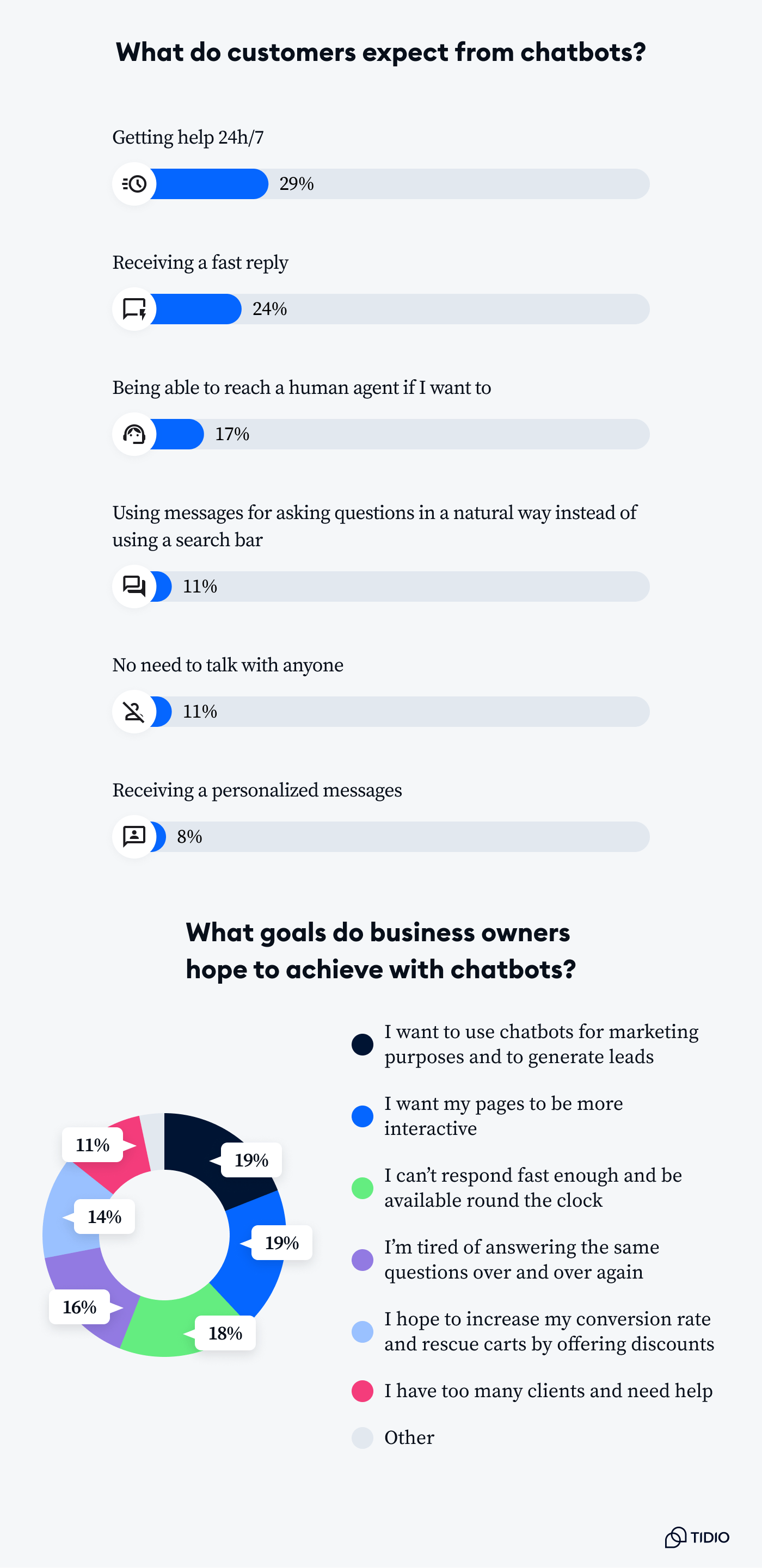
Gone are the days of robotic autoresponders—today’s chatbots are customizable, engaging, and serve as capable virtual shopping assistants. And the fact that they’re incredibly efficient and can handle a large number of requests simultaneously is why businesses fell in love with chatbots.
Speaking about business—
How much money can chatbots save?
Chatbots currently account for about $20 million in business cost savings. This number will continue to grow as more businesses adopt the technology. It’s not surprising, as chatbots can save businesses up to 30% of costs on customer support alone.
If we look at these numbers from the perspective of the global AI chatbot market size of $1.34 billion (for 2024), it looks truly incredible. The average ROI for chatbots is about 1,275% (and that’s just support cost savings).
But the chatbot industry itself is only the tip of the iceberg.
Chatbots don’t just save money—they can help you earn it. According to our research, the median order value increase stands at about 20% for online stores that implemented chatbots. And that’s after only the first 7 days of using them.
So—
How effective are chatbots?
Our study shows that most businesses are very satisfied with how chatbots have improved their customer service and marketing operations.
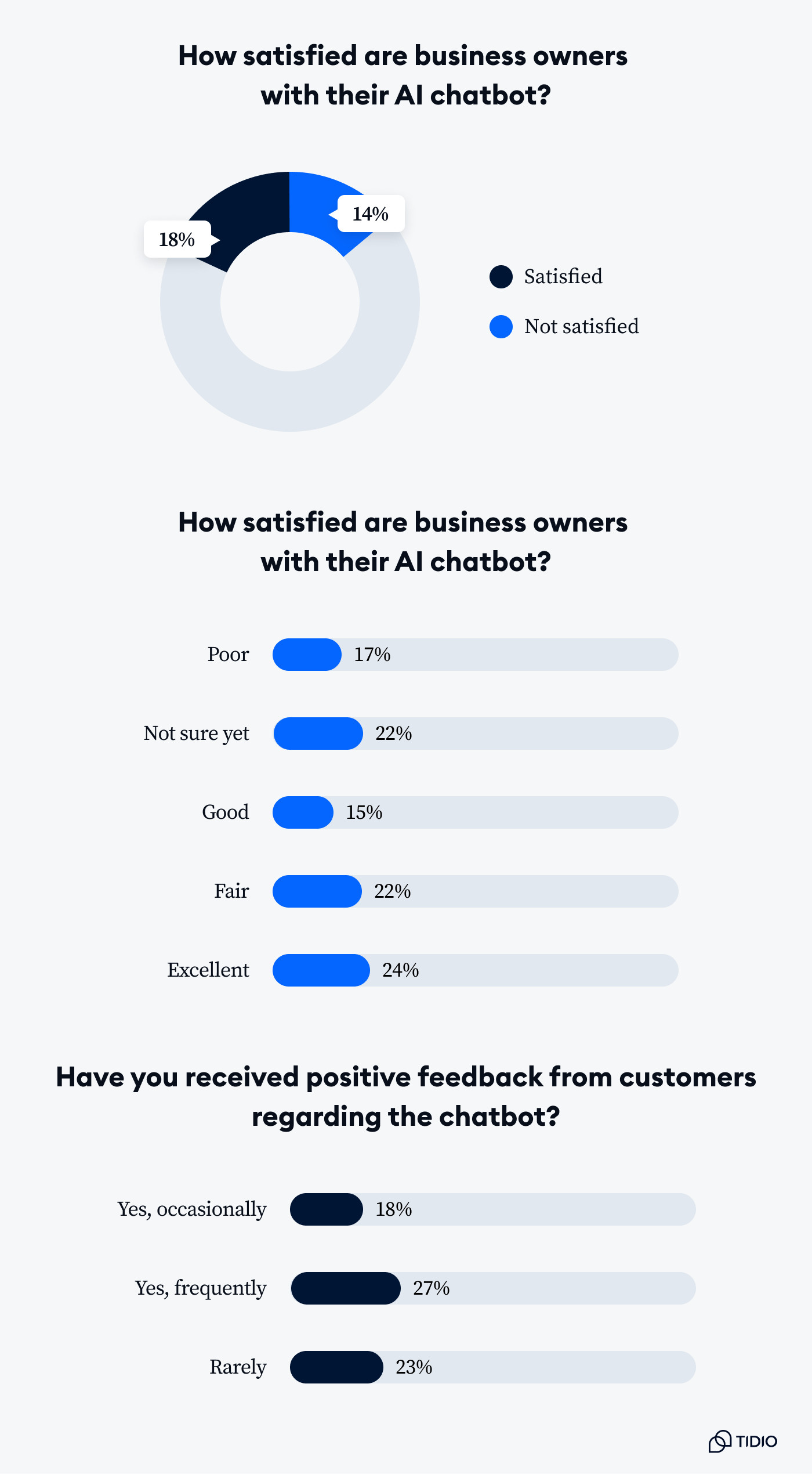
Chatbots help businesses forget about many customer support-related problems. Our respondents indicated that they wanted to be available round the clock (50%), automate customer service (44%), stop answering the same questions over and over again (38%), and save costs (29%).
Other reasons for implementing chatbots include marketing purposes and lead generation (27%), increasing conversion rates (27%), and making pages more interactive (25%). The great news is that 55% of businesses achieved exactly what they wanted with chatbots.
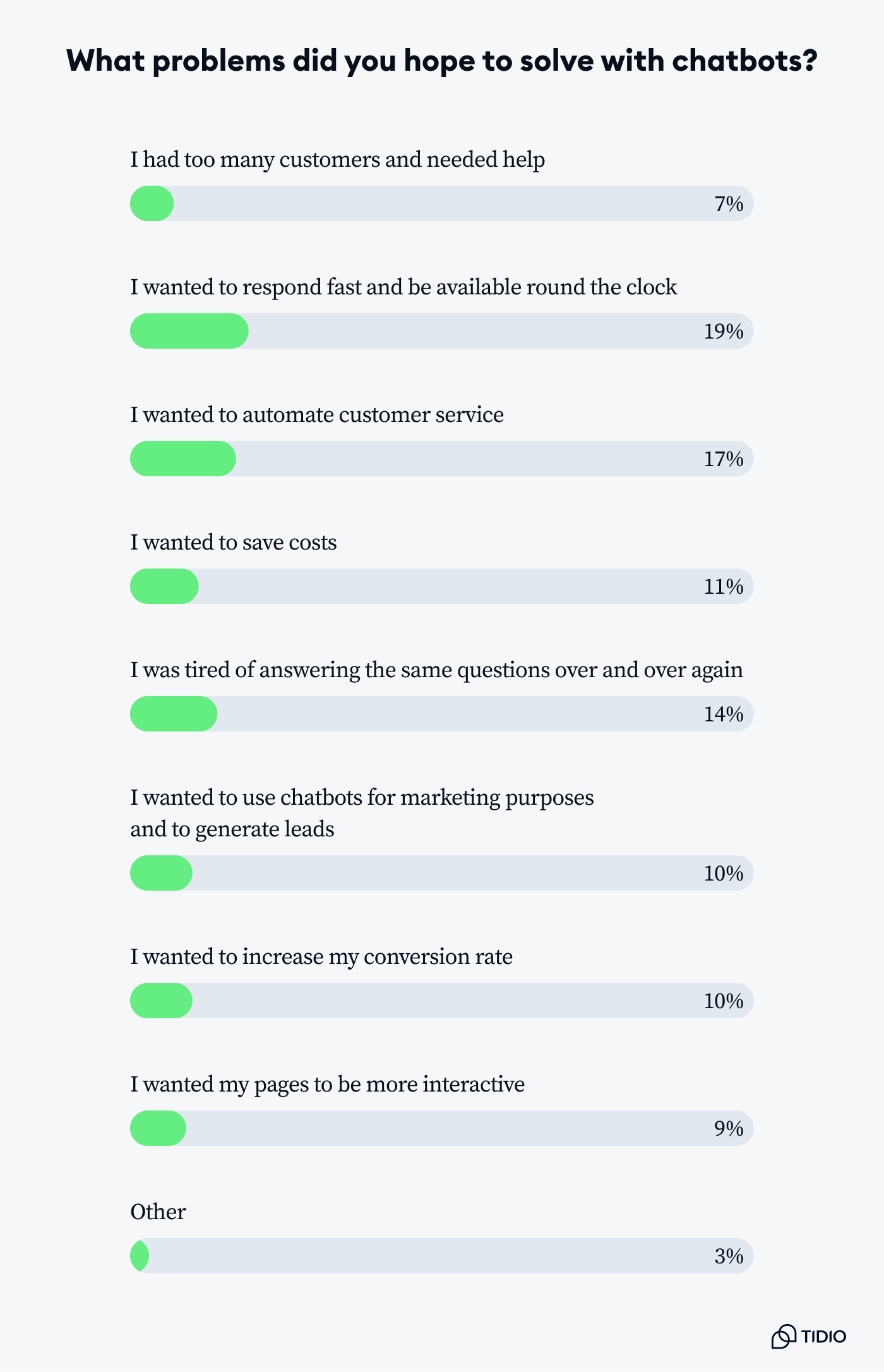
We wanted to find a tool that allowed us to curate our customer’s journey by customizing and implementing automations that could respond to shoppers’ questions promptly, guide them through the purchasing process, and ultimately boost sales without losing our personal touch.

Read more: Check out our case study to see how eye-oo increased their sales and decreased waiting times with Tidio.
People associate chatbots with online support and getting help. However, chatbots have other applications, too.
Chatbot conversion rates
Claims about chatbots boosting conversions are often exaggerated. While in some industries chatbots increase sales by up to 70%, there’s no universal benchmark, and it’s hard to track all ecommerce transactions linked to chatbots.
Instead, it’s more useful to focus on engagement rates for different types of chatbot messages. For instance, 6% of users may respond to a CSAT score request, while upselling and discount bots often see higher engagement. Here’s a breakdown of AI chatbot stats related to customer interactions.
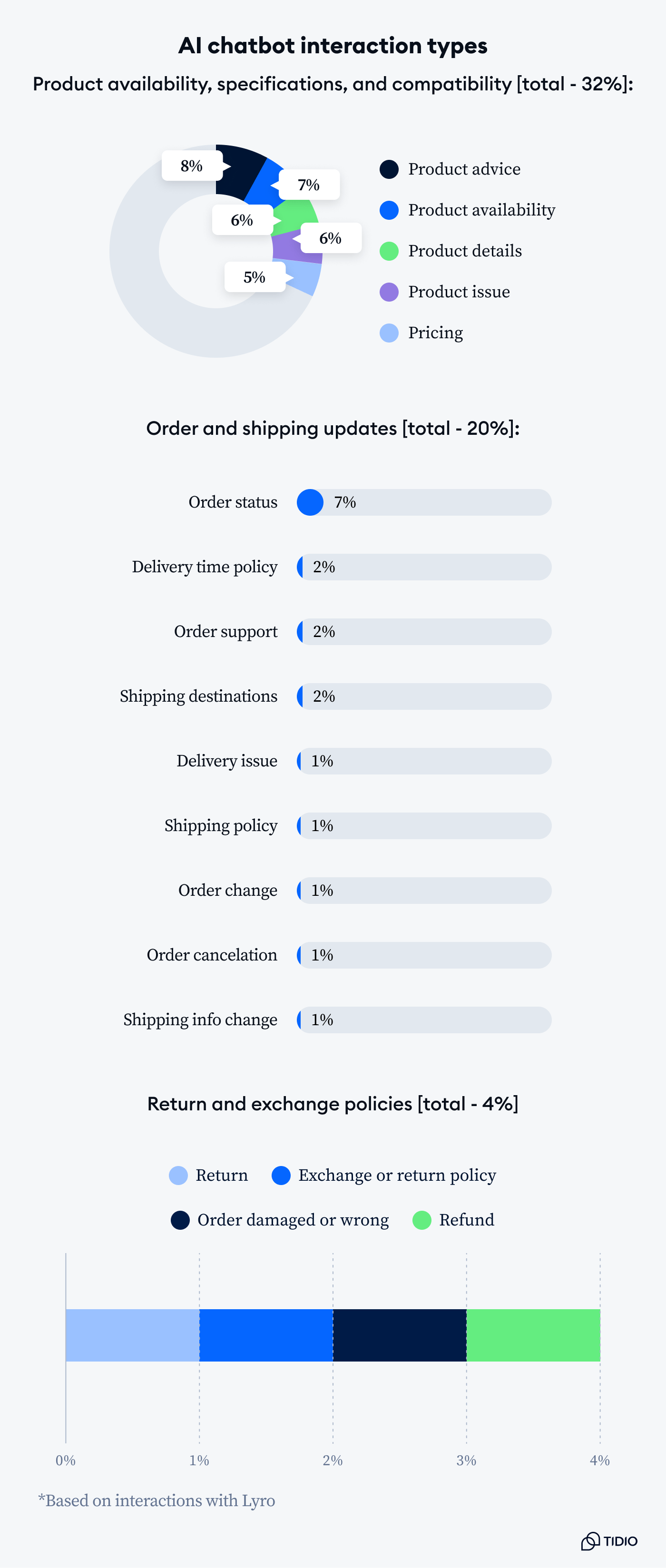
The more specific and contextual chatbot messages are, the more customer interactions they generate. Since 2022, there’s been a growing trend toward specialized chatbots.
This means chatbots need to handle complex conversations, provide accurate information, and reduce “AI hallucinations.” Additionally, they must meet customer expectations for quick and precise responses.
Chatbots influence the experience of both businesses and their customers. Let’s see what the latter think of this technology.
What customers expect from chatbots
We asked users what they expect from chatbots. It turned out that response time is the most important issue for them. Interestingly, the results coincide perfectly with the business goals of companies that want to get a chatbot for their websites.
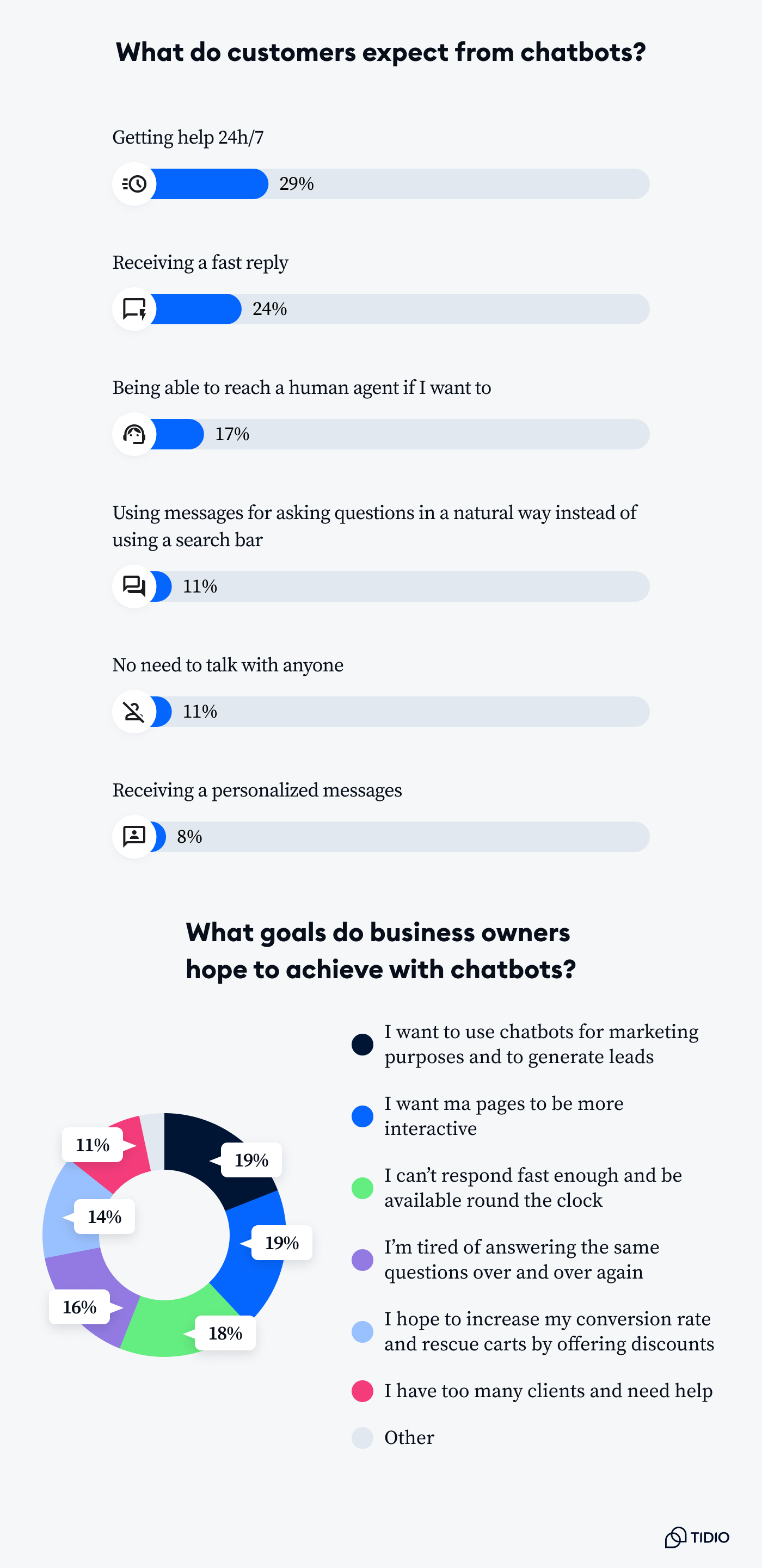
Our survey shows that customers expect:
- Receiving a quick response at any time and any day of the week
- Being able to reach a live agent if needed
The absolute majority of consumers are very impatient and declare that they would use a chatbot rather than wait even a few minutes for a human support agent. The speed of response contributes to a positive chatbot experience that is all about receiving accurate answers to simple questions, fast.
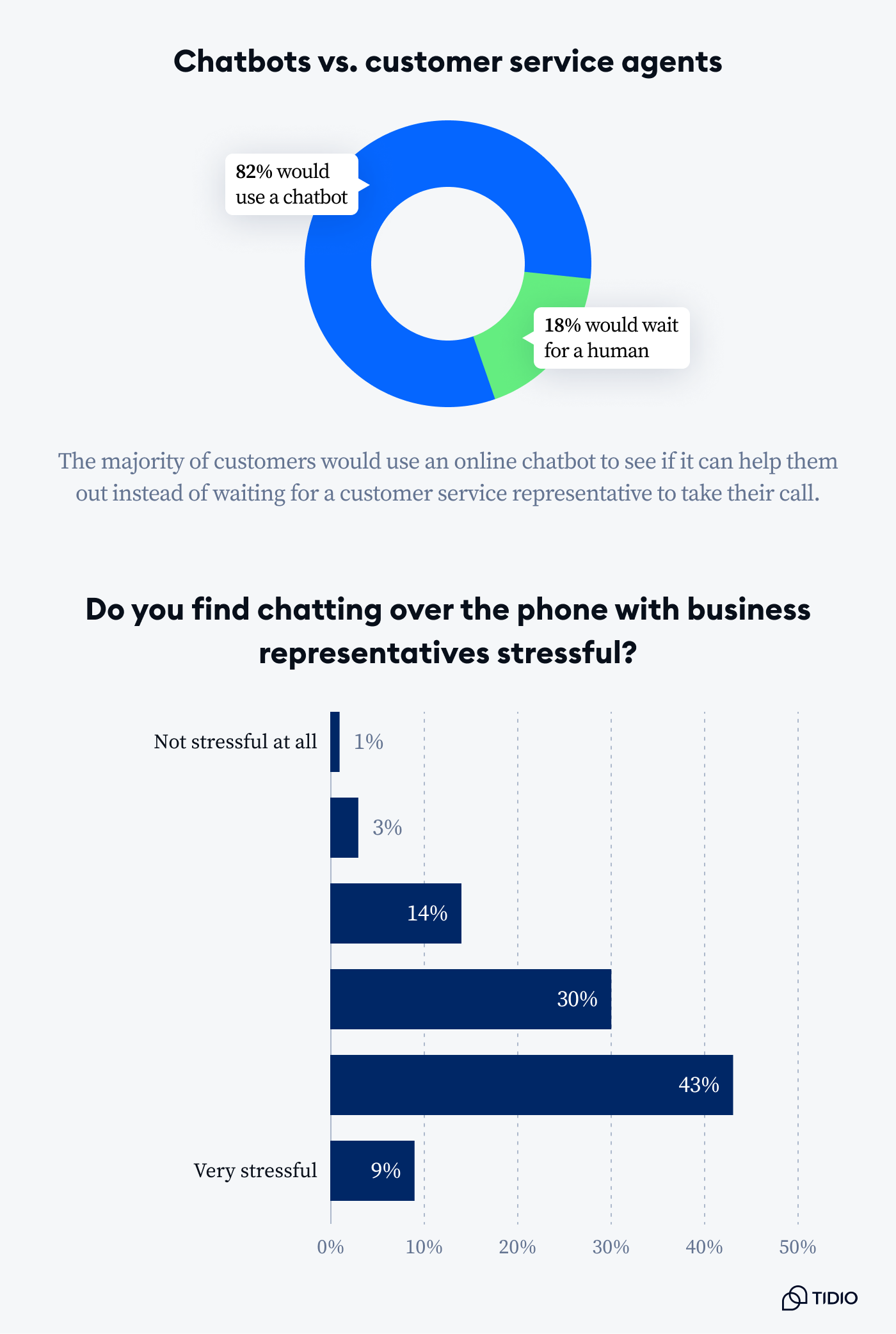
The majority of customers are pretty stressed out when it comes to calling customer support representatives. Hence, many problems remain unsolved, and customers stay dissatisfied. And a solid AI chatbot is usually the best way around stressful phone calls. Bots contribute to the convenience of online shopping because they are available 24/7, anywhere, in any language.
It’s safe to say that traditional call centers are becoming obsolete. So much so that a whopping 94% of people think that AI chatbots will make call centers obsolete and drive them out of the market.
Also, as many as 96% of consumers think that companies should use chatbots instead of traditional support teams. This is truly bad news for businesses that reject modern customer service software solutions.
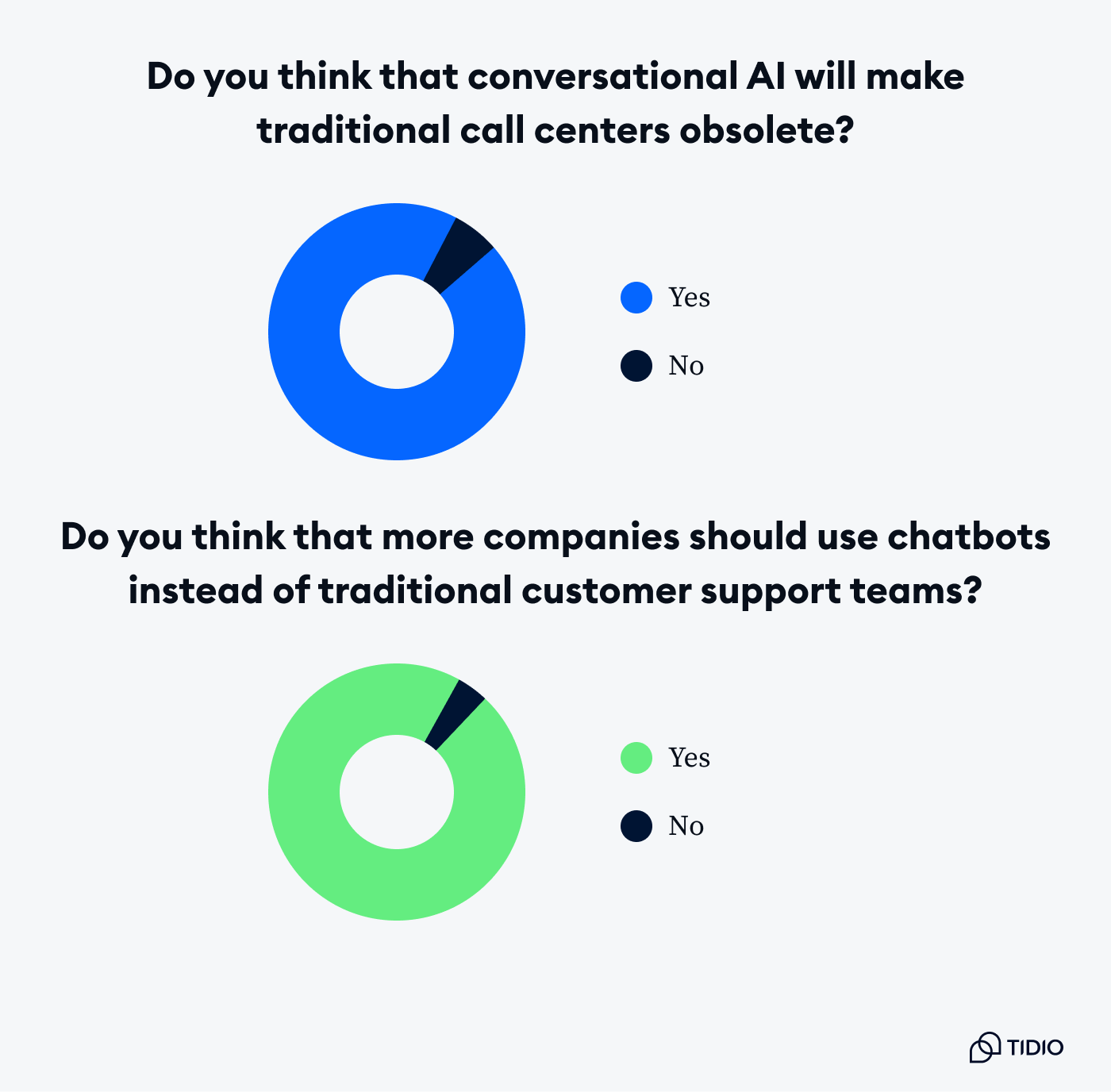
These numbers reflect growing trust in AI chatbots. While they can have occasional glitches, the public seems ready to embrace them, especially as the technology keeps improving.
Currently, about 64% of people trust AI chatbots—a significant shift from the past when fear of AI was much stronger. Additionally, around 60% of consumers say chatbots frequently influence their purchasing decisions. And why not, when chatbots provide such valuable assistance?
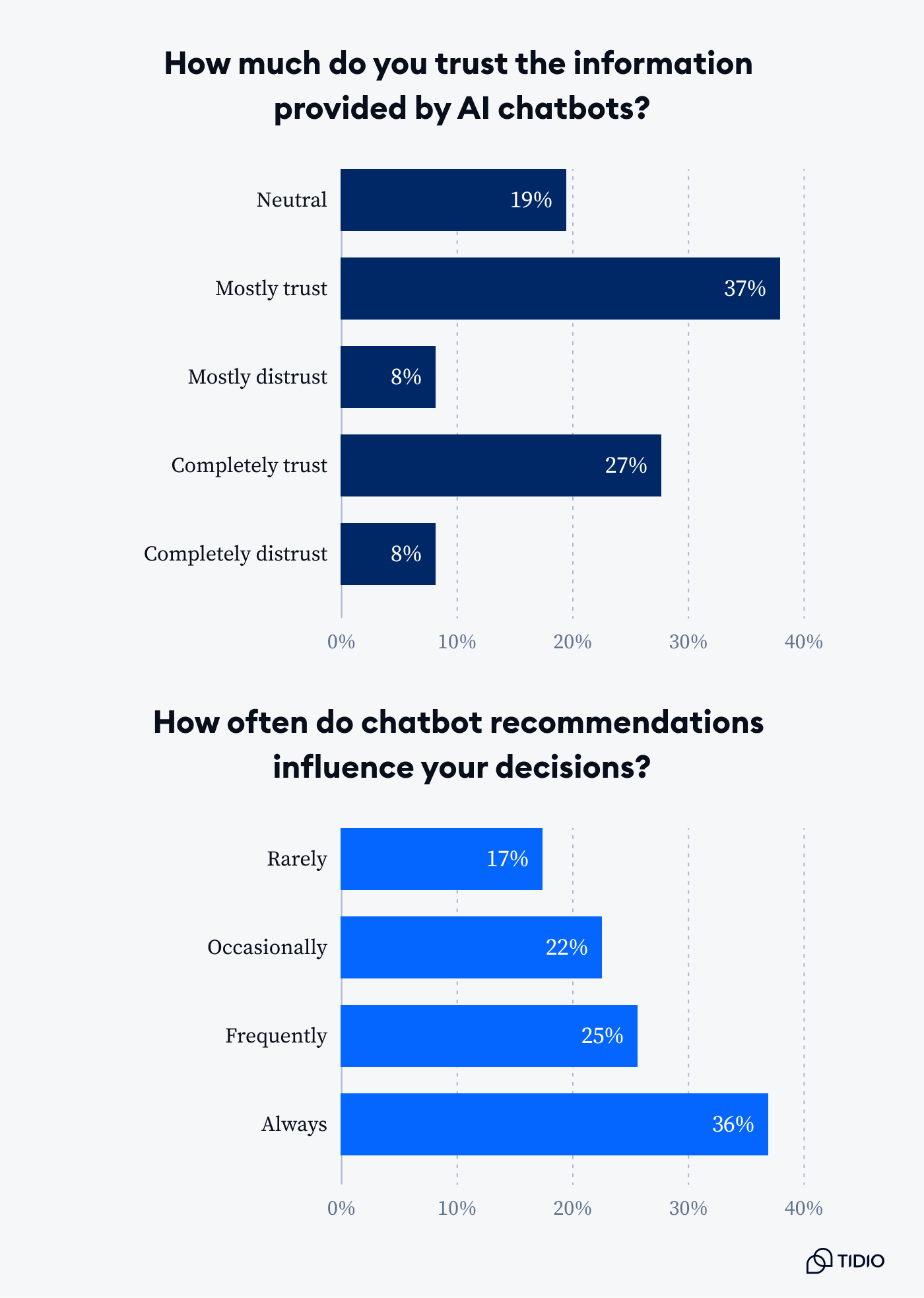
Let’s get into the demographics for a moment, What do Gen Z, the youngest generation of customers, think about chatbots?
Generation Z and chatbot trends
Many studies have tried to show that Millennials and Generation Z are extremely keen on new technologies and chatbots. However, these observations may prove to be a bit of an overreaching interpretation.
It’s true that Gen Z-ers spend more time online, on mobile apps, social media, and messaging apps. But they’re also quite skeptical of full customer service automation.
While the youngest segment of consumers appreciates the convenience of instant messaging powered by AI, only 44% of Gen Z internet users believe that chatbots will make traditional customer support call centers obsolete.
Still, around 20% of Gen Z shoppers prefer to start their customer service experience with chatbots rather than talking to human agents. Compared to only 4% of boomers, this is quite a big difference.
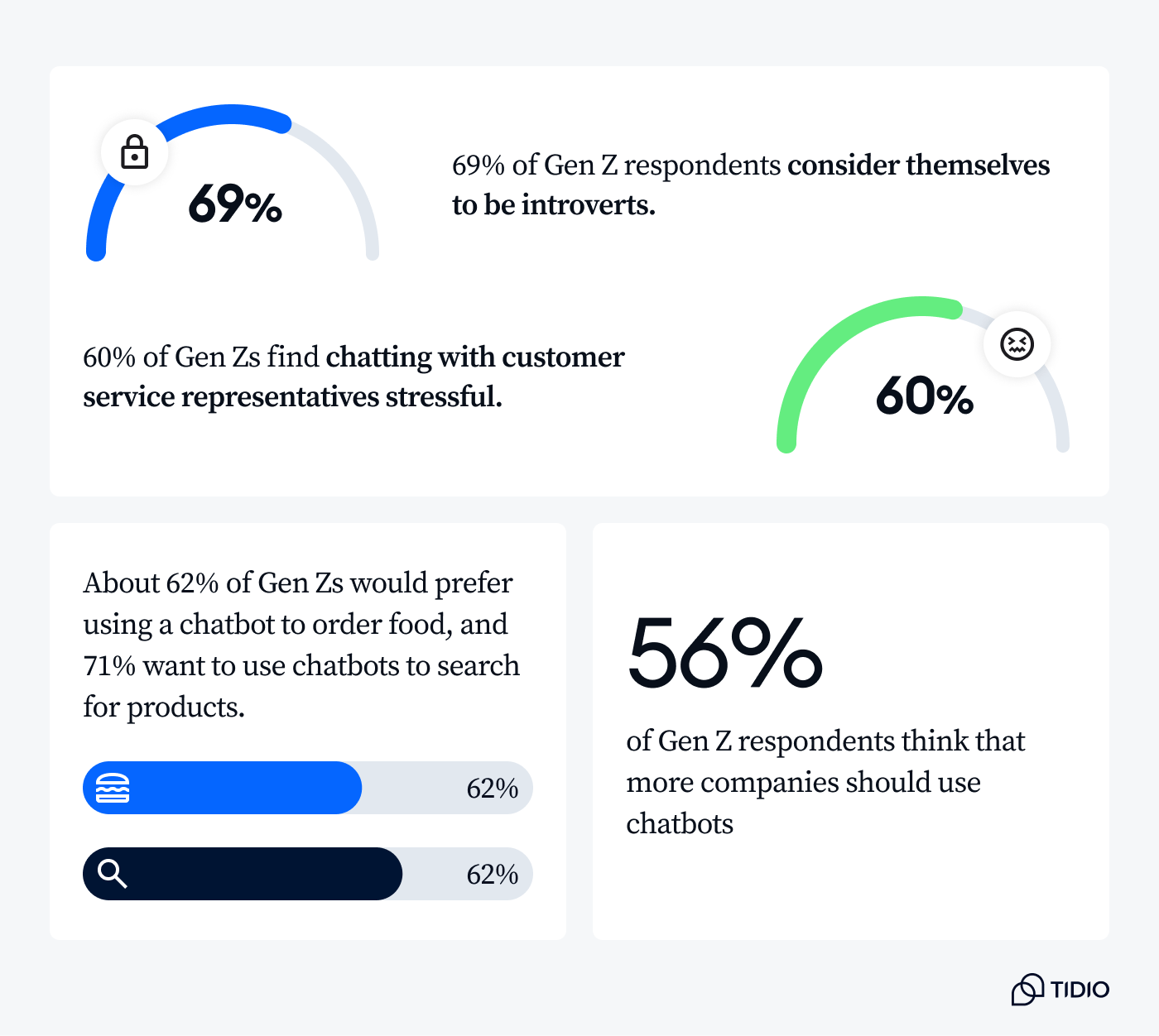
Businesses should try to meet customer expectations whenever possible. Whether they provide chatbots or offer direct human contact depends on which option is more convenient for a specific communication channel. Shoppers value both quick answers from chatbots and real-time assistance from live chat agents when they need help.
Of course, there’s always some room for improvement. Below are some chatbot challenges that developers have been trying to overcome.
Chatbot challenges and opportunities
Chatbots offer various benefits for businesses. They can help increase customer engagement and loyalty, drive sales, and improve operational efficiency. Additionally, chatbots can provide businesses with valuable data insights that can help improve marketing efforts and product development.
Still, chatbots are still a relatively new technology. There are some inherent pitfalls to them.
Challenges:
- Nuances of human language—during a natural conversation, the context is constantly changing. An AI may have a hard time keeping up and understanding customer needs at a given moment. And the most important thing for any customer service environment is to have an accurate recognition of problems.
- Misuse of chatbot interfaces—chatbots are supposed to be intuitive and understand natural language. Some customers overthink it and try to test chatbot functionalities using all variants of chat conversation flows. As a result, they focus on the interface and chatbot as a gimmick instead of a tool to solve their problems.
- Development and implementation costs—creating your own bot from scratch can be an expensive endeavor that requires time, expertise, and a lot of experimentation. But there are many out-of-the-box AI chatbot development services and brands to choose from, too.
Nonetheless, AI chatbots are a 1:1 answer to the needs of today’s consumers and business owners. Companies using chatbots for customer service have already discovered that they:
- Provide instant responses around the clock
- Deliver a consistent user experience to customers
- Drastically reduce customer support costs and resources needed
It’s difficult to miss the exact correspondence between what customers expect and what chatbots can deliver.
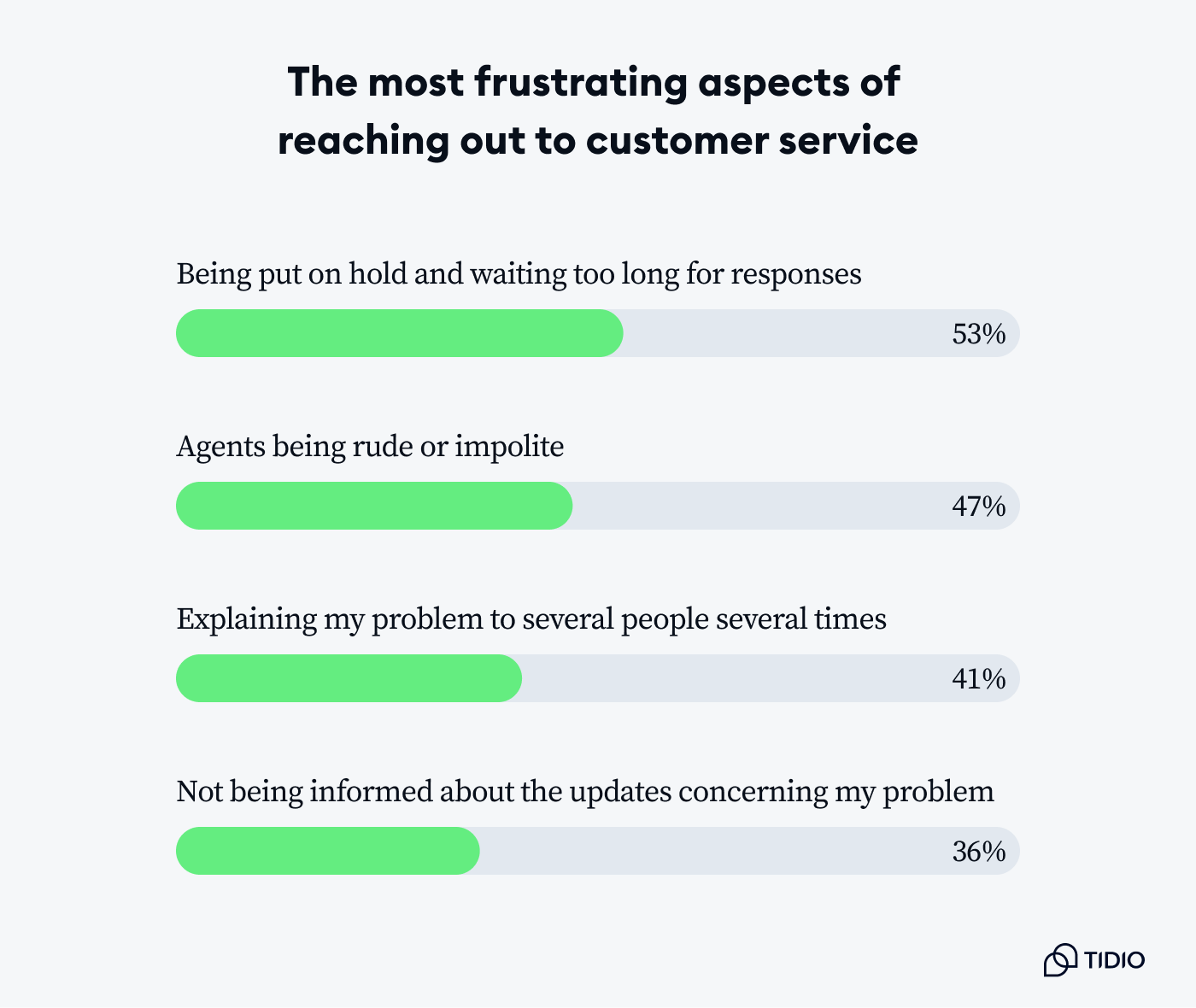
Ultimately, chatbots offer a cost-effective way for businesses to solve common customer service problems, connect with customers in a more personal way, and improve their overall customer experience.
Chatbot statistics: bonus points
It’s clear that chatbots are heavily influencing practically every sphere of life and business. Here is some data proving the impact of chatbots on finance, healthcare, HR, and marketing.
Chatbot marketing trends:
- Marketing is the third most common application for chatbots, holding 17% of the total market share
- Around 80% of marketing and sales leaders have implemented or planned implementation of AI bots into customer experience
- As many as 55% of companies using chatbots for marketing experience a rise in high-quality leads
HR chatbot statistics:
- Career websites get 95% more leads by engaging with jobseekers through chatbots
- For many HR departments, bots help to free up more than 12,000 work hours annually
- In 2023, 75% of HR queries globally occurred through HR chatbots
Chatbots in finance:
- The size of chatbot market in BFSI (banking, financial services, and insurance) is estimated to reach nearly $7 billion by 2030
- The use of financial services chatbots can help customers save around 4 minutes per inquiry which will directly add value to customer satisfaction
- As many as 43% of banking customers prefer to resolve issues through a chatbot
- Around 80% of financial institutions see chatbots as a great opportunity to enhance their client service
Chatbots in healthcare:
- By 2026, the healthcare chatbots market will reach $543 million, growing at a 15% rate
- Around 52% of patients in the US acquire their health data through the use of healthcare chatbots
- Currently, around 68% of health organizations are incorporating AI
- Globally, healthcare chatbots help to save as much as $3.6 billion
- Medical professionals think chatbots could be useful for booking medical appointments (78%), finding healthcare facilities (76%), and offering information about medications (71%)
AI Chatbot statistics: conclusion
While there may be some concerns about AI increasingly taking over aspects of our daily lives, chatbots are widely regarded as a valuable tool by both consumers and businesses.
Are there too many companies using chatbots?
Our research suggests otherwise. Only 4% of customers feel that businesses shouldn’t use any chatbots, only human agents. In contrast, the absolute majority of respondents report positive experiences with AI bots, appreciating the convenience and efficiency they offer.
Maximize sales and revenue with intelligent NLP-powered chatbots
Sources:
- Chatbot Market Size, Share & COVID-19 Impact Analysis 2020-2027
- Chatbots: Vendor Opportunities & Market Forecasts 2020-2024 (Juniper Research)
- Chatbot Market in 2022: Stats, Trends, and Companies in the Growing AI Chatbot Industry
- Brand Strategies for Conversational Interfaces (Chatbots Magazine)
- The Ultimate List of Marketing Statistics for 2022 (HubSpot)
- 2021 State of Conversational Marketing Report by Drift
- The Future of Gen Z Marketing Has Chatbot Written All Over It
- Chatbots Will Appeal to Modern Workers (Gartner)
- Chatbots Are Here to Stay (Accenture Chatbot Stats)
- Despite Challenges, Salesforce Says Chatbot Adoption Is Accelerating (Venture Beat)
- Healthcare Chatbots Market Size Worth USD 543.65 Million by 2026 at 19.5% CAGR (Market Research Future)
- Digital Banking Users Are Turning to Chatbots (Insider Intelligence)
- Size of chatbot in banking, financial services and insurance (BFSI) market worldwide in 2019 and 2030 (Statista)
- The A.I. revolution in health care is coming
- Physicians’ Perceptions of Chatbots in Health Care: Cross-Sectional Web-Based Survey
- How HR Is Using Virtual Chat and Chatbots (SHRM)
- Banking Chatbots – Revolutionizing customer service
- Chatbot Marketing: The Catalyst for Business Growth
Methodology:
The research was carried out in 2024. For this study about chatbot trends, we collected answers from 1015 respondents. We used an internal survey displayed in the main panel of our dashboard and Amazon’s Mechanical Turk.
Respondents from the consumer segment were 59.8% males and 39.5% females. The sample’s average age was 35 with a standard deviation of 8.
Respondents had to answer about 20 questions, the majority of which were scale-based or multiple-choice. The survey had an attention check question.
Fair Use Statement:
Has our research helped you learn more about chatbots and current trends in conversational AI? Feel free to share chatbot statistics from this study. Just remember to mention the source and include a link to this page. Thank you!

